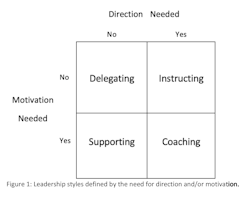Empathic Leadership and the Three-Term Contingency
Four different leadership styles or approaches to optimize desirable behavior and attitude vary as a function of the amount of direction and motivation needed. These distinctions connect directly to the three-term contingency of behavior-based safety—the activator-behavior-consequence (ABC) foundation of applied behavioral science (ABS).
Activators precede behavior and provide direction through written or verbal prompts, reminders or instructions. Consequences motivate the recurrence of a desirable behavior with genuine recognition, appreciation or gratitude for the performance of that behavior. ABS researchers and practitioners use the terms behavioral directive or feedforward, and behavioral support or feedback for activators and consequences, respectively.
Managers typically practice one efficient approach to hold people accountable, whereas leaders take time to understand another individual’s perspective before giving direction, advice or support. In other words, leaders listen with empathy, and then lead with empathy. The result is empathic leadership.
People can lead others in four distinct ways. Specifically, leaders coach, instruct, support or delegate depending on their empathic diagnosis of the individual(s) and the situation. How do these four approaches to leadership differ?
The Three-Term Contingency
The essential difference between these four leadership styles can be linked to the three-term contingency of ABS. That is, leadership varies to the extent it provides direction (as a behavioral activator or feedforward) and/or motivation (as a behavioral consequence or feedback).
Sometimes it is most appropriate to offer both direction and motivation when leading people. At other times, it is best to limit specific direction and motivation when giving an assignment to an individual or work team. Blanchard et al. (1985) refer to the former approach as coaching, and the latter leadership style as delegating.
Coaching Leadership: Effective coaches provide both feedforward and feedback. They present a plan, including the specific behaviors required for a certain task, and then follow up with supportive and corrective feedback to pinpoint what worked well and what could be improved. Periodic activators (feedforward) keep people on the right track, while intermittent consequences (feedback) provide motivation to keep people performing well. The letters of coach define the sequence of steps in this leadership process: “C” for Care, “O” for Observe, “A” for Analyze, “C” for Communicate, and “H” for Help.
Delegating Leadership: Sometimes, it is best to state an assignment in general terms (without specific directions) and to limit interpersonal behavior-focused feedback. This happens when experienced team members are already motivated to do their best and will give each other direction, support and feedback when needed. These individuals are self-motivated and often use self-management techniques to keep themselves motivated and on the right track.
Instructing Leadership: Some people are highly motivated to perform well, but they do not know exactly what to do. This is often the case with new hires. They want to make a good first impression, and the newness of the job is intrinsically motivating. However, they are nervous because of response uncertainty. They are not sure what to do in the relatively novel situation. In this case, leaders need to focus on providing behavior-focused instruction that includes supportive and corrective feedback.
Supporting Leadership: Some people require more support than direction. Consider, for example, the experienced worker who does the same sequence of tasks day after day. This individual does not need direction, but benefits from periodic expressions of sincere appreciation and gratitude for a job well done.
There are times when experienced workers know what to do, but they do not perform up to par all of the time. This is not a training issue, but rather one of execution. Supportive leaders recognize this and provide the kind of empathic support that boosts motivation. This could involve broadening a job assignment, varying the task components or assigning leadership responsibilities. At the very least, it includes the delivery of one-to-one recognition and appreciation in ways that increase a person’s sense of importance and self-worth.
Figure 1 summarizes these four leadership styles, as defined by whether direction and/or motivation is/are needed. So how do you know which leadership style to use? This is where empathy is crucial. Your assessment of people and their situational circumstances—through observing, questioning and listening—will determine which approach to use. Look for two critical characteristics: competence and commitment.
Competence and Commitment
Coaching is needed when a person’s competence and commitment are relatively low. You can improve competence through behavior-focused feedforward and feedback, and you can increase commitment by periodically expressing sincere appreciation and gratitude. Anything that increases a person’s perception of importance or self-worth on the job can enhance commitment. How can you make that happen? A solution is not always obvious. However, by observing, asking questions and listening with empathy, you can learn how to activate and/or support an individual’s motivation or commitment.
Delegating is relevant when people know what to do (competence) and are motivated to do it (commitment). Delegating leaders provide clear expectations and show sincere appreciation for worthwhile work. They enable and support self-direction and self-motivation.
Empathic leaders usually know when an individual or work team advances to the delegation level because they have observed successive progress. However, it is often useful to ask people whether they are ready for this style of leadership. If they say “No,” then ask what they need to reach this delegation stage. Do they need more competence through direction? Do they need more commitment through some kind of support the organization could make available?
Instructing leadership is needed when people are internally motivated to perform well but do not know how to maximize their efforts. In this case, empathic leaders focus on giving specific behavior-focused direction.
Supporting leadership is needed when people know what to do but do not always follow through appropriately. People need supportive leadership when their motivation or commitment is relatively low. This is particularly evident when workers perform irregularly or inconsistently. Their good days indicate they know what to do, but their bad days suggest a motivational issue. These employees need support, but what kind and how much? Only through empathic observing, questioning and listening can leaders obtain answers to these crucial questions.
Causes of low commitment can vary dramatically from interpersonal conflict on the job to emotional upheaval at home. You can discover such causes and consider solutions through empathic listening. At times, diagnosing and treating a motivational problem requires special professional assistance. In this case, the best you can do is recognize a need for professional help and offer relevant advice and support.
Reveal Your Leadership Style
You might want to consider the benefits of: a) telling people what leadership style you plan to use, b) requesting permission to use a particular approach, or c) asking an individual or team what leadership style they would prefer. This is particularly useful when changing from one leadership approach to another. If you feel it is time to progress from giving instructions to delegating, announce your plan for a leadership adjustment, explain your reasons and solicit feedback.
Leadership is most effective when everyone involved understands the four approaches and the two critical factors that determine the need for one style over the others. Then people can request a particular leadership style from their flexible and empathic leaders.
E. Scott Geller, Ph.D., Alumni Distinguished Professor, is director of the Center for Applied Behavior Systems at Virginia Tech. He is a co-founder and senior partner of Safety Performance Solutions Inc. and GellerAC4P Inc.
References
Allen, J. (1990). I saw what you did and I know who you are: Bloopers, blunders and success stories on giving and receiving recognition. Tucker, GA: Performance Management Publications.
Blanchard, K., Zigarmi, P., & Zigarmi, D. (1985). Leadership and the one-minute manager. New York: William Morrow.
Carnegie, D. (1936). How to win friends and influence people. New York: Simon & Schuster, Inc.
Daniels, A. C. (1999). Bringing out the best in people (2nd Edition). New York: McGraw-Hill, Inc.
Foti, R. J., & Boyd, K. B. (2016). Leadership, followership, and AC4P. In Geller, E. S. (Ed.), Applied psychology: Actively caring for people (273-294). New York: Cambridge University Press.
Geller, E.S. (2016). The psychology of self-motivation. In Geller, E. S. (Ed.), Applied psychology: Actively caring for people (83-118). New York: Cambridge University Press.
Geller, E. S. (2020). Life lessons from psychological science: Understanding and improving interpersonal dynamics. San Diego, CA: Cognella Academic Publishers.
Geller, E. S., & Geller, K. S. (2021). The human dynamics of achieving an injury-free workplace: Safety directives from psychological science. Newport, VA: GellerAC4P, Inc.
Watson, D.L., & Tharp, R. G. (1997). Self-directed behavior: Self-modification for personal adjustment (7th Edition). Pacific Grove, CA: Brooks/Cole Publishing Co.
About the Author
E. Scott Geller
E. Scott Geller, Ph.D., Alumni Distinguished Professor, just completed his 50th year as a teacher and researcher in the Department of Psychology at Virginia Tech, and Director of the Center for Applied Behavior Systems. He a co-founder and Senior Partner of Safety Performance Solutions, Inc., and GellerAC4P, Inc.—www.gellerac4p.com.

